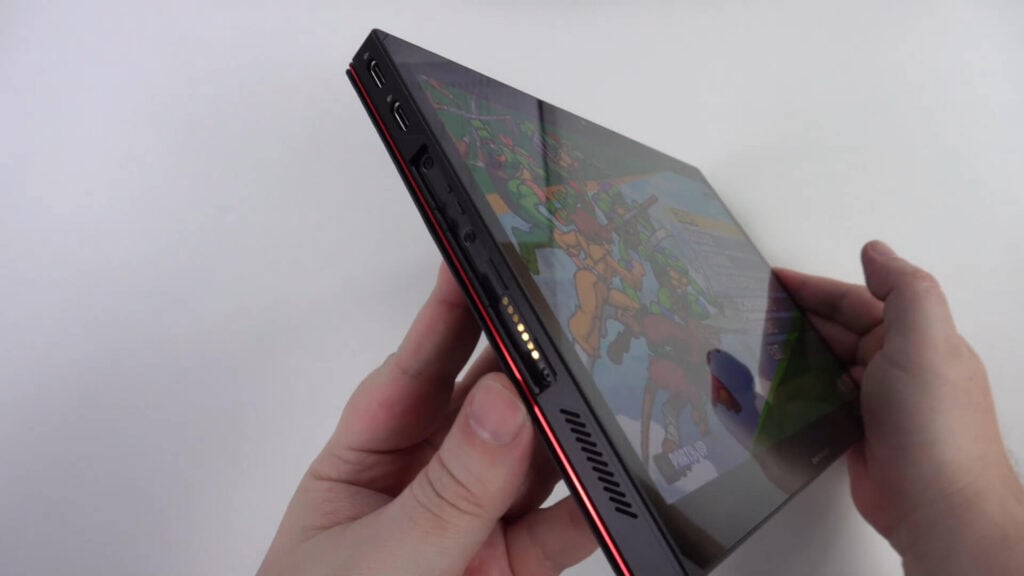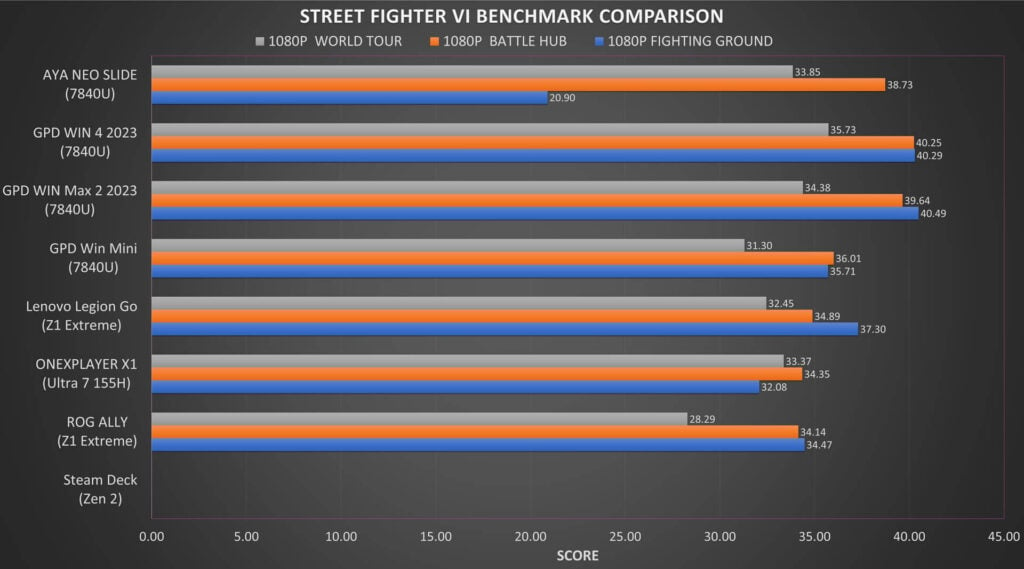ONEXPLAYER X1 Anmeldelse
-
Design
(4.5)
-
Build Quality
(4.5)
-
Display
(5)
-
Performance
(4)
-
Features
(4.5)
Sammendrag
ONEXPLAYER X1 er en allsidig 3-i-1 spillhåndholdt, nettbrett og bærbar PC med banebrytende ytelse.
Totalt sett
4.5Brukeranmeldelse
( votes)Fordeler
- CPUer med høy ytelse
- 3-i-1 allsidig formfaktor
- Stor 10,95″ skjerm
- Omfattende tilkoblingsmuligheter, inkludert OcuLink
- God batterilevetid
Ulemper
- Ikke like rask som AMD Ryzen-konkurrentene for spilling
ONEXPLAYER X1 er annonsert som en 3-i-1 håndholdt; nettbrett, bærbar PC og håndholdt spill-PC med avtakbare kontrollere. I vår ONEXPLAYER X1-gjennomgang, la oss sjekke ut Intel Ultra 7-modellen og se hvordan den kan sammenlignes med sine AMD Ryzen-kolleger, så vel som med ONEXGPU.
ONEXPLAYER X1 - anmeldelsesvideo
Utpakking av ONEXPLAYER X1
Vi starter vår ONEXPLAYER X1-gjennomgang med unboxing. Først ut av esken har vi en brukerveiledning som er på kinesisk og engelsk. Deretter har vi ONEXPLAYER X1 bærbar gaming PC selv, vi vil vise det i mer detalj i et øyeblikk.
Inne i esken finner du en lader og en USB-kabel. Vi inkluderer riktig adapter for ditt land.
Den mobile spill-PC-en ONEXPLAYER X1 har separat kjøpte kontrollere som festes på hver side av X1. Dessverre var de ikke tilgjengelige på anmeldelsestidspunktet, men vi vil sjekke dem ut i en egen video når vi får tak i dem.


Et bærbart tastatur som forvandler X1 til en bærbar datamaskin, er også tilgjengelig separat.
Oversikt over ONEXPLAYER X1
Vi fortsetter vår ONEXPLAYER X1-gjennomgang med en oversikt over funksjoner og tilbehør. ONEXPLAYER X1 måler rundt 9,9 x 6,4 x 0,52 tommer og veier rundt 789 g uten kontrollerne.
Den 10,95″ store skjermen er en LTPS-berøringsskjerm og støtter opptil 2560×1600 oppløsning, 16:10-sideforhold med 120 Hz oppdateringsfrekvens. Rett over skjermen er det et AI-kamera som støtter ansiktsgjenkjenning for Windows Hello.

På venstre side har vi to USB 4-porter for tilkobling av strøm og høyhastighetsutstyr. Under er det et avtakbart deksel som avslører kontakten på venstre side av kontrolleren.
På høyre side finner du en USB 3.2-port og et spor for micro SD-kort, samt et annet deksel til høyre for kontrolleren.
Øverst, fra venstre til høyre, finner du en strømknapp med fingeravtrykkssensor, etterfulgt av volumknappene. Det er et annet deksel som avslører en 3,5 mm lydport og en Oculink-port for å koble til en ekstern eGPU. Og det er en knapp som bringer opp ONEXPLAYER-overlegget og programvaren.
Bunnen har en pogo pin-design med magneter som du kan bruke til å koble til og feste tastaturet i. Det følger med et bakdeksel som beskytter mot riper, og det har også et innebygd stativ hvis du for eksempel ønsker å plassere det på et skrivebord.
Det bærbare tastaturet, som er tilgjengelig separat, festes på undersiden av X1. Når det først er festet, kan det ikke løsne ved et uhell. Tastene har en fin størrelse og svært lav profil, noe som gjør det raskt og enkelt å skrive på. Jeg hadde ingen problemer med å bruke tastaturet, bortsett fra den første tilvenningen til et nytt tastatur. Tastene var lette å trykke på og intuitive etter kort tids bruk. Et lite irritasjonsmoment var at det ikke finnes noen magneter som holder tastaturet lukket når det ikke er i bruk.
ONEXPLAYER X1 Tekniske spesifikasjoner
I den neste gjennomgangen av ONEXPLAYER X1 tar vi en nærmere titt på spesifikasjonene og tester batterilevetid, viftestøy og termiske egenskaper.
| ULTRA 7 | ULTRA 5 | |
| CPU | Intel Core Ultra 7 155H | Intel Core Ultra 5 125H |
| KORN/TRÅDER | 16 kjerner, 22 tråder | 14 kjerner, 18 tråder |
| GPU | Intel Arc-grafikk @ 2,25 GHz | Intel Arc-grafikk @ 2,2 GHz |
| RAM | 32 GB/64 GB LPDDR5x 7467 MHz | 16 GB LPDDR5x 7467 MHz |
| OPPBEVARING | 1 TB/2 TB PCIe 4 m.2 SSD | 1 TB PCIe 4 m.2 SSD |
Begge modellene deler følgende spesifikasjoner:
| DISPLAY | 10,95″ LTPS 10-punkts berøringsskjerm, 2560×1600 oppløsning, 120 Hz oppdateringsfrekvens, 540 nit lysstyrke, 138 % SRGB |
| KOMMUNIKASJON | Wi-Fi 6E, Bluetooth 5.2 |
| BATTERI | 65,02Wh 16890mAh batteri |
| KAMERA | AI-kamera med ansiktsgjenkjenning for opplåsing av Windows Hello |
| I/O | 2x USB 4 1x USB-A 3.2 1x OcuLink 1x Micro SD-kortleser 1x 3,5 mm lyd |
| STØRRELSE | 9,9 x 6,4 x 0,5 tommer (25,2 x 16,3 x 1,3 cm) |
| VEKT | 789g |
Det hele drives av et batteri på 65,02 Wh og 16890 mAh. I testene våre kjørte vi Cinebench-multikjerne-referansen i en loop, og fikk 1 time og 50 minutter. Veldig bra sammenlignet med AMD-håndholdte!
I våre tester av viftestøy og temperatur under kjøring av Cinebench fikk vi en høyeste viftestøy på 61 db og en høyeste temperatur på 59 °C.
Systembenchmarks
Som en del av vår ONEXPLAYER X1-gjennomgang vil vi benchmarke og sammenligne resultatene med andre enheter, inkludert GPD WIN Mini, GPD WIN MAX 2 og AYANEO Slide.
PCMARK
Vår første test er PCMark, som kjører en rekke tester på tvers av ulike bruksområder som nettsurfing, videokonferanser, arbeid med store kontordokumenter og bildegjengivelse.
Vi fikk en poengsum på 6 079, noe som generelt sett er ganske bra, bare slått av ROG Ally- og GPD WIN 4-modellene. De andre enhetene har en merkbart lavere forskjell i ytelse.
Cinebench
Cinebench-referansen tester CPU-enes enkeltkjerne- og flerkjerneytelse.
Vi får poengsummer på 1 766 og 11 275 for enkelt- og flerkjerneytelse. ONEXPLAYER X1 tar omtrent førsteplassen for enkeltkjerneytelse med ROG Ally på 2. plass. Men for flerkjerneytelse ser vi at bordene snus med 2. plass fra bunnplass i ytelse.
3DMark
For 3D Mark kjører vi de vanlige Time Spy-, Night Raid- og Fire Strike-benchmarkene.
X1 tar ledelsen i Time Spy-benchmarken med 3 790 poeng. Vi ser at AMD 7 000-enhetene ligger rundt flere hundre poeng bak her. Men i Night Raid- og Fire Strike-testene ser vi at X1 faller bak i begge resultatene.
Benchmarks for spill
Og vi kunne ikke lage en ONEXPLAYER X1-anmeldelse uten noen spillbenchmarks.
Forza Horizon 5
Vi kjører Forza Horizon 5 med svært lave grafikkinnstillinger. Vi vet fra tidligere tester at AMD-prosessorer generelt utkonkurrerer Intel-prosessorene i dette spillet. Vi kan se at mønsteret fortsetter med X1 som henger etter på tvers av referanseverdiene. Selv om vi får over 60 FPS ved 720P 15W og over, ser vi at AMD-modellene har langt høyere score.
Shadow of the Tomb Raider
I våre Shadow of the Tomb Raider-referansetester kjører vi på de laveste grafikkinnstillingene. Vi ser et generelt tettere gap enn tidligere mellom Intel X1 og AMD-baserte enheter, men forspranget tilhører AMD igjen. Selv Steam Deck presterte bedre enn X1.
Street Fighter VI
I vår Street Fighter VI-referansetest ved 1080P maksimale grafikkinnstillinger ser vi et nærmere utvalg av bilder per sekund. Den klarer å holde seg ganske nær AMD-rivalen, men ikke noe som setter den i ledelsen.
Oculink-ytelse
Siden X1 har OcuLink, kan vi også teste ytelsen med ONEXPLAYER ONEXGPU som en del av vår anmeldelse av ONEXPLAYER X1. Du kan også bruke GPD G1 eGPU, de har omtrent samme ytelse.
Kombinasjonen av ONEXPLAYER X1 kompakt gaming-PC og ONEXGPU fungerer svært godt sammen. Vi kan se fra diagrammene på skjermen at med en eGPU kommer den nærmere ytelsesnivået til en AMD-basert håndholdt PC med eGPU. Det er ikke stor forskjell mellom dem når den integrerte GPU-en ikke brukes.
Sammendrag av referanseindeksen
En rask merknad i vår ONEXPLAYER X1-gjennomgang angående referanseresultatene. Vi kan definitivt tilskrive noe av den manglende ytelsen til grafikkdriverne. Intels drivere er i en tidlig fase for Ultra 5- og 7-prosessorene, og vi så noen forskjeller, både gode og dårlige, sammenlignet med da vi prøvde X1 i forrige måned med eldre drivere.
Vi så de samme innledende ytelsesproblemene for AMD 6 og 7 tusen prosessorer da de først ble lansert, og de økte i ytelse over tid. Jeg tror imidlertid ikke Ultra 7 vil nå det stadiet der den vil slå AMD 7 tusen-serien.
Spillytelse
Vi har plukket ut noen spill på måfå og vil vise litt gameplay inkludert lyd. Sjekk videoen ovenfor for opptakene.
Avsluttende tanker
Når vi kommer til slutten av vår ONEXPLAYER X1-anmeldelse, vil vi oppsummere våre tanker. Som en 3 i 1-basert enhet kan vi ikke direkte sammenligne med de dedikerte håndholdte spill-PC-ene, da dette er mer en hybrid, spesielt uten kontrollerne.

Men vi kan sammenligne ytelsen, som de AMD-baserte enhetene generelt overgår på de fleste områder. Den eneste virkelige seieren for ONEXPLAYER X1 håndholdt gaming datamaskin var batterilevetiden, hvor vi så nesten to timer på Cinebench sammenlignet med vanligvis rundt 60 til 75 minutter på AMD-baserte enheter.
Med en eGPU ser vi svært god ytelse når den underpresterende integrerte GPU-en er ute av bildet. Hvis en eGPU er en del av planene dine, eller du allerede eier en, gjør det X1 mye mer fristende.

Den håndholdte spill-PC-en ONEXPLAYER X1 har fordelen av den massive 10,95″ tommers skjermen som ser flott ut. Jeg hadde en mus og det bærbare tastaturet koblet til, og du kan bruke den som et mini-skrivebord. Det er ikke nødvendig å ty til en skjerm fordi skjermen er liten som på de håndholdte.
Med ONEXPLAYER-kontrollerne eller til og med din egen kontroller kan du lene deg tilbake og spille på denne skjermen på et bord, for eksempel. Det er litt mer komfortabelt enn å sitte tett inntil en liten skjerm mens du bruker en ekstern kontroller.
Vi må vente og se hvordan det spiller og føles med den offisielle kontrolleren. X1 vil være den største håndholdte med kontroller vi har prøvd, og den kan være litt for stor og tung til å være komfortabel.
La oss få vite hva du synes om ONEXPLAYER X1 i kommentarfeltet. Ville du valgt Intel fremfor AMD for en håndholdt, foretrekker du små eller store håndholdte? Du kan lese mer og kjøpe din ONEXPLAYER X1 her.
Det avslutter vår gjennomgang av ONEXPLAYER X1, hvis du har spørsmål, kan du gjerne stille i kommentarfeltet.






























